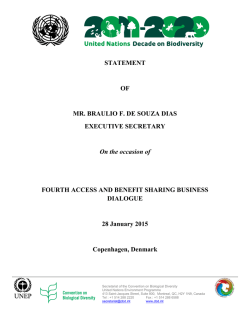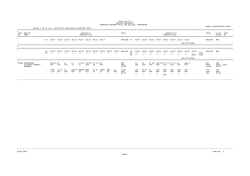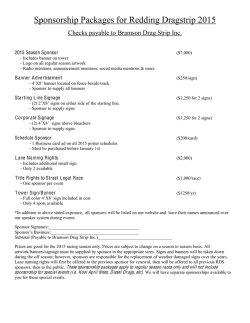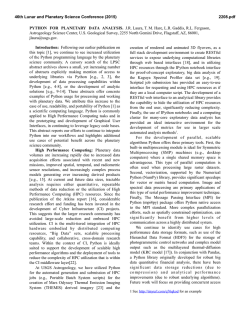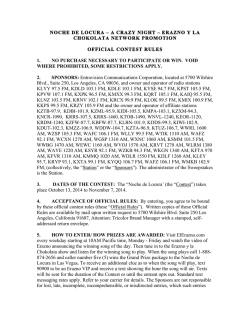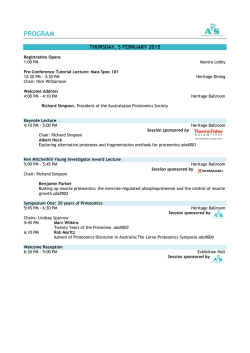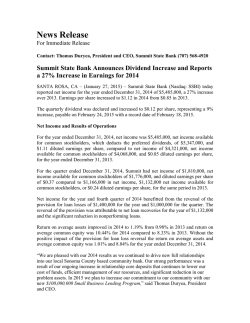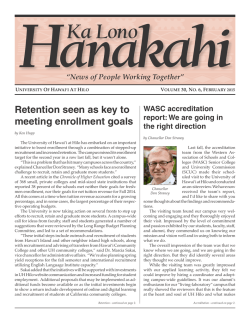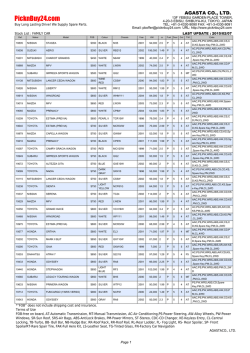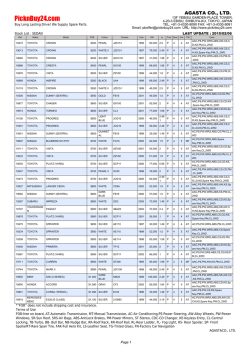
View the PDF version - Pepper Hamilton LLP
Financial ServicesAlert January 28, 2015 Berwyn | Boston | Detroit | Harrisburg | Los Angeles | New York | Orange County | Philadelphia | Pittsburgh | Princeton | Silicon Valley | Washington, D.C. | Wilmington The Risk Retention Rules: A Victory for Securitizations Involving Residential Mortgage-Backed Securities? Frank A. Mayer, III | [email protected] Andrew J. Victor | [email protected] When Congress passed the Dodd-Frank Act, it mandated the creation of risk retention rules in an effort to align the incentives of sponsors of asset-backed securities (ABS) with the interests of investors and to improve the underwriting and selection of securitized assets. As with much of the Dodd-Frank Act, Congress left the details of the risk retention requirements to be developed by various agencies. After more than three years of development, the Board of Governors of the Federal Reserve System, the Department of Housing and Urban Development, the Federal Deposit Insurance Corporation, the Federal Housing Finance Agency, the Office of Comptroller of the Currency and the Securities and Exchange Commission (collectively, the Agencies) jointly issued the risk retention rules on October 22, 2014. The rules were then published in the Federal Register on December 24, setting off the rules’ one- and two-year periods for the industry to conform operations. • This alert provides an overview of the significant features of the risk retention rules, including the following: • generally, sponsors of ABS must retain a minimum of 5 percent of the credit risk from an ABS transaction • the Agencies issued the risk retention rules that include collateralized loan obligations (CLOs) and other securitization transactions. the regulations provide an exemption for ABS collateralized with qualified residential mortgages (QRMs) and exceptions for ABS collateralized with commercial loans, commercial real estate loans and automobile loans with heightened underwriting standards. Who Must Comply with the Risk Retention Requirements? In a word, “sponsors” must comply with the risk retention requirements. The regulations define a “sponsor” as a person who organizes and initiates a securitization transaction by selling or transferring assets, either directly or indirectly, including through an affiliate or issuer. What Are the Risk Retention Requirements? The minimum risk retention requirement, located at section 15G of the Securities Exchange Act of 1934, as amended by Ssection 941 of the Dodd-Frank Act, is no less than 5 percent for any asset that a sponsor, through the issuance of ABS interests, transfers, sells or conveys to a third party, unless an exemption applies. The Agencies did not increase the minimum requirement of 5 percent from section 15G, but they noted that parties to a securitization transaction are free to agree that more risk should be retained. Although the rules do not prohibit more than one sponsor from participating in a securitization, they do not allow multiple sponsors to divide the required risk retention. Furthermore, sponsors are generally prohibited from transferring or hedging the interests they retain for two years from the date of the closing for the securitization, although the time limit for residential mortgage-backed securities (RMBS) is five years. What Is an “ABS Interest” under the Risk Retention Requirements? The risk retention requirements apply to the issuance of “ABS interests.” Under the risk retention rules, the Agencies defined an “ABS interest” generally as any type of interest or obligation issued by an issuing entity, whether or not in certificated form, including a security, obligation, beneficial interest or residual interest, payments on which are primarily dependent on the cash This publication may contain attorney advertising. The material in this publication was created as of the date set forth above and is based on laws, court decisions, administrative rulings and congressional materials that existed at that time, and should not be construed as legal advice or legal opinions on specific facts. The information in this publication is not intended to create, and the transmission and receipt of it does not constitute, a lawyer-client relationship. Internal Revenue Service rules require that we advise you that the tax advice, if any, contained in this publication was not intended or written to be used by you, and cannot be used by you, for the purposes of (i) avoiding penalties under the Internal Revenue Code or (ii) promoting, marketing or recommending to another party any transaction or matter addressed herein. Please send address corrections to [email protected]. © 2015 Pepper Hamilton LLP. All Rights Reserved. flows of the collateral owned or held by the issuing entity. As such, the definition applies to RMBS, commercial mortgagebacked securities (CMBS), auto and auto lease-back securities, revolving pool securitizations and asset-backed commercial paper conduits. In a somewhat controversial decision, the Agencies’ regulations include CLOs as well.1 Under the rules, a CLO is a special purpose entity that issues debt and equity interests and whose assets consist primarily of loans that are securitized assets and servicing assets. Sponsors of transactions involving CLOs that are securitized by the purchase of assets on the secondary market, known as “open-market CLOs,” must comply with the risk retention requirements. Conversely, the definition of an “ABS interest” does not include common stock, partnership interests or trust certificates. Similarly, rights to receive payments for services provided by the holder of such rights, including servicing, trustee services and custodial services, are also not ABS interests. When Must Sponsors Comply with the Risk Retention Requirements? The risk retention requirements will become effective one year from the date of publication in the Federal Register for RMBS and two years from the date of publication for other ABS. Therefore, the compliance deadlines are, respectively, December 24, 2015 for RMBS and December 24, 2016 for other ABS. How Can Sponsors Comply with the Risk Retention Requirements? As concerns the form through which a sponsor retains its risk, the regulations offer a “menu of options,” including a “standard” option, because the Agencies perceived a need to accommodate the variety of the securitization structures covered by the final rule. Under the “standard” risk retention option, the minimum 5 percent amount held by a sponsor must be in the “issuing entity,” which the regulations define as the entity that owns or holds the pool of assets to be securitized and in whose name the ABS are issued. The regulations permit a sponsor to shape its form of risk retention by providing the choice of retaining an “eligible horizontal residual interest,” retaining an “eligible vertical interest” or retaining a combination of such interests. Eligible Horizontal Residual Interest. In selecting to retain an “eligible horizontal residual interest,” a sponsor will retain the most subordinate 5 percent interest of the issuing entity. In doing so, the regulations generally require sponsors to disclose information about their interests to investors. In particular, a sponsor will, in most instances, have to disclose the expected fair 2 www.pepperlaw.com value for its interest calculated pursuant to GAAP, the actual fair value post-closing, any material differences in making its calculations before and after closing and a description of its methodology to assess fair value. Alternatively, a sponsor may fund an account at the closing of the securitization in an amount equal to the same dollar amount as would be required to hold an eligible horizontal residual interest, thereby creating an “eligible horizontal cash reserve account.” Because the purpose of the risk retention rules is to keep the sponsor exposed to credit risk, the funds in the account are restricted to ensure that cash will be available to absorb losses to the same extent as an eligible horizontal residual interest. Eligible Vertical Interest. A sponsor may also elect an “eligible vertical interest,” whereby the sponsor retains either (i) a minimum 5 percent of each class of ABS interests issued in the securitization or (ii) a single vertical security that provides the sponsor 5 percent of the cashflows or losses on each class of the issued ABS interests. Important caveats: • the rules permit sponsors to combine holdings of horizontal residual interests and vertical interests, informally known as an “L-shaped interest,” to meet the 5 percent requirement • sponsors electing to meet their risk retention requirements under the standard option may also offset some of the retained risk if interests in the ABS are acquired by the entity (the “originator”) that created and sold the asset that collateralizes the ABS • the regulations prohibit sponsors from using third-party credit support, such as insurance policies, guarantees or standby letters of credit. What Are the Other Options for Risk Retention? In addition to standard risk retention for ABS, the regulations permit sponsors to meet specific risk retention requirements for various other securitizations, including revolving pool securitizations, asset-backed commercial paper conduits, CMBS and municipal bond repackaging securitizations. Although the 5 percent risk retention requirement applies to each of these kinds of securitizations, the specific requirements for compliance may vary due to the nature of the underlying assets. For instance, on one hand, sponsors of ABS collateralized by commercial real estate loans can meet their risk retention requirements if third-party purchasers acquired eligible horizontal residual interests in the issuing entity, reflecting the historical market Financial ServicesAlert practice of third-party purchasers acquiring first loss positions in CMBS transactions. On the other hand, sponsors of municipal bond repackaging securitizations, also known as “tender option bonds,” may elect the standard option or retain a 5-percent facevalue amount of the municipal securities of the same issuance. Regarding CLOs, sponsors generally must retain a minimum 5 percent of the face amount of the CLO until a terminating event, such as maturity or default. The regulations permit the risk retention requirement to be satisfied if the “lead arranger” (effectively the underwriter) of each CLO-eligible loan agrees to retain at least 5 percent of the contributed loan. Are There Exemptions or Exceptions to the Risk Retention Requirements? Yes, the regulations afford several exemptions and exceptions. Importantly, ABS securitized solely by QRMs are exempt from the risk retention requirements. In making the QRM exemption, the Agencies aligned the definition of a QRM with the detailed definition of “qualified mortgages,” or “QMs,” under section 129C of the Truth in Lending Act and that statute’s regulations developed by the Consumer Financial Protection Bureau. The regulations provide that the Agencies will reevaluate the QRM definition in December 2018 and will periodically review thereafter every five years to determine whether the definition is limiting credit risk, promoting sound underwriting and providing access to credit. Additionally, the regulations provide an exception of a 0 percent risk retention requirement for ABS with commercial loans, commercial real estate loans and automobile loans made under heightened underwriting standards. For securitizations involving these three kinds of loans, sponsors may also reduce their risk retention requirement up to 2.5 percent by creating a transaction that draws upon the loans with the heightened underwriting standards and loans that do not qualify. The amount of the reduction in risk retention is measured by the ratio of the two different types of loans. Several other exemptions, such as for securitizations involving assets issued, insured or guaranteed by the federal government; student loans made under the Federal Family Education Loan Program; and seasoned loans are available. Even though not labeled as an exemption, Fannie Mae and Freddie Mac, as sponsors, may meet their risk retention requirements if they fully guarantee the timely payment of principal and interest on all ABS interests and are under conservatorship or receivership with capital support from the United States. Pepper Points: Financial institutions will have to make business decisions about whether to combine retention of horizontal residual and vertical interests. As recognized by the Agencies, holding a single vertical security provides financial institutions with the simplest way to meet their risk retention requirements. Additionally, we expect that financial institutions will be attracted to the vertical security option because the disclosure requirements for fair value only apply to eligible horizontal residual interests. Financial institutions will be forced to choose whether they will deal in ABS that qualifies for the 0 percent retention requirement or if they will create ABS subject to the risk retention requirements by pooling qualifying loans and nonqualifying loans. Depending on the availability of the assets that meet the higher underwriting standards, strategies for successful pooling with be critical for ABS with commercial mortgages, commercial loans and automobile loans. However, qualifying for an exemption under the heightened underwriting standards is difficult and may prove to be a disincentive. Because the risk retention requirements will require banks to list the retained interests on their balance sheets, banks will have to meet higher regulatory capital requirements. We expect this development to spur the migration of certain financial products away from banks to non-bank financial institutions, such as hedge funds. In light of the exemptions for QRMs and ABS of Fannie Mae and Freddie Mac, a large segment of all RMBS will not be covered by the risk retention requirements. This will incentivize sponsors to market ABS with qualifying assets so as to avoid the risk retention requirements. Endnote 1. Due to the inclusion of CLOs without an exemption, the Loan Syndications & Trading Association sued the Securities and Exchange Commission and the Federal Reserve in federal court, seeking review of the Agencies’ decision. The case is Loan Syndications & Trading Association v. SEC, No. 14-1240 (D.C. Cir.). www.pepperlaw.com 3
© Copyright 2024
